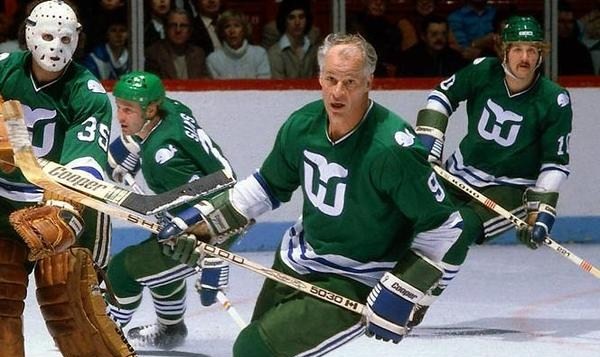They still mourn in Hartford.
Twenty years have passed since the pucks dropped for the final 41 times at the Hartford Civic Center. For 18 years, the NHL called Hartford its home at the corner of Trumbull and Asylum Streets.
Asylum St. could not have been more appropriate. Maybe those of us who lived in Connecticut in the 1980s and ‘90s were crazy to think our love affair with the NHL would last forever.
But for 18 mostly frustrating but always-hopeful seasons, we embraced the Hartford Whalers for all their faults on and off the ice, never wanting to let them slip back into the dark, treacherous ocean of league expansion and greener, southern climates.
But it did all come to a heartbreaking end in 1997, when owner Peter Karmanos moved the Whalers out of Hartford and into North Carolina.
The date that everyone recalls is April 13, 1997, when the Whalers played their final game in Hartford – and franchise hero Kevin Dineen scored the franchise’s final goal at the Civic Center.
That final, fateful regular season began on Oct. 5, 1996 –twenty years ago this week—the final home opener at the Civic Center. The Whalers defeated the Phoenix Coyotes, 1-0. Perhaps that opponent was prophetic, as the NHL’s concerted effort to introduce its product into the southern half of the United States is ultimately what doomed the Whalers to their fate.
The Coyotes were in their first season in Phoenix when they opened in Hartford, having just relocated from Winnipeg. The Jets and Whalers were two of four teams – along with the Quebec Nordiques and Edmonton Oilers – to merge out of the old World Hockey Association (WHA) into the NHL in 1979 – the last league merger to occur in major American professional sports.
The Oilers, led by Wayne Gretzky and a savvy GM in Glen Sather, won five Stanley Cups from 1984-90, but by the mid-1990s, all four former WHA franchises were floundering in their NHL cities, and one-by-one, the migration south began.
The Nordiques were the first to go, relocating from Quebec City to Denver for the 1995-96 season. Winnipeg followed suit in 1996 with its departure to sunny Phoenix. Even the Oilers were on the brink of relocating to Houston in 1998 before a local ownership group was able to keep the team in Edmonton.
The Whalers had no such hero to rescue them in 1997. It became clear once Karmanos bought the franchise in 1994 that relocation was his ultimate goal, and when talks with the state of Connecticut about building a new arena broke down in early 1997, the die was cast.
It ended an 18-year run that saw the Whalers win a grand total of one playoff series, earning the dubious nickname Forever .500s, for their extreme run of mediocrity. None of it mattered to the Whalers diehards who endured the Civic Center roof collapse in 1978, who kept their radios tuned to play-by-play man Chuck Kaiton on WTIC-AM when the Whalers played Vancouver and LA on late West Coast nights, who cheered for legends like Gordie Howe and Blaine Stoughton, giving way to Ronnie Francis and Dineen and Ulfie Samuelsson.
It was that latter trio that spearheaded that one magical playoff season in 1986, which was almost enough to offset the other years of disappointment. After having not reached the playoffs since their inaugural NHL season in 1979-80 – led by 50-year-old Gordie Howe and his two sons, Mark and Marty – the Whalers rose above the waves in 1985-86 to challenge for a playoff berth.
GM Emile “The Cat” Francis traded for star goalie Mike Luit and assembled a top scoring line featuring Francis and Dineen and a defense anchored by Samuelsson, Dave Babych and Joel Quenneville to give the Whalers its most talented roster in franchise history.
With a late-season surge, the Whalers earned the fourth seed in the Adams Division, then throttled the Nordiques in a three-game sweep in the opening round, winning the clincher 9-4 at the Civic Center.
Up next was the Montreal Canadiens, with a rookie goalie named Patrick Roy. The Whalers pushed the heavily-favored Habs to a Game 7, famously winning Game 4 in overtime when Dineen blew past defensive stalwart Larry Robinson and roofed the puck past Roy at a delirious Civic Center.
But on April 29, 1986 — the same night the rest of New England tracked the mounting strikeout total by a young Red Sox pitcher named Roger Clemens in a game against Seattle — the Whalers’ dream season died at the Forum in Montreal. It was the hated Claude Lemieux, going glove-side high on Luit at 5:55 of overtime, sending the Whalers home with a devastating defeat.
So grateful were Whalers fans for their brief taste of playoff glory – and with the inescapable thought that a Game 7 win might have opened the door to a Stanley Cup title (the Canadiens cruised to the Cup after the Whalers series) — the city of Hartford threw their fourth-place finishers a championship-style parade.
The Whalers would go on to win their only Adams Division title in 1987, but a first-round loss to the Nordiques signaled the end of Hartford’s flirtation with a Stanley Cup title. First-round Game 7 losses to their New England rivals, the Boston Bruins, in 1990 and the Canadiens again in 1992 proved to be the last time the Whalers would even sniff playoff success.
By then, Francis and Samuelsson had been traded to Pittsburgh, and other ill-conceived moves gutted the franchise.
But while the Whalers would quietly swim off to Greensboro in 1997 – becoming the Carolina Hurricanes and eventually arrived in Raleigh, where they finally won a Stanley Cup in 2006 – the Whalers would leave behind a footprint in the sports culture that still lingers today.
What other franchise can claim a more popular theme song – or any song for that matter – than the “Brass Bonanza”? The jaunty tune was the Whalers’ victory march, played whenever the team was introduced before the start of a period or, more famously, after every goal at the Civic Center. The song’s legacy would endure in New England even after the Whalers’ departure, as the Red Sox would use the tune in their rotation to celebrate runs at Fenway Park, including during its historic 2004 march to the World Series championship.
Even now, the Brass Bonanza plays in the hearts of Whalers fans who still dream of the day the NHL returns to the Insurance City. Asylum St., indeed.
This article originally appeared in the weekly Arena Digest newsletter. Are you a subscriber? Click here to sign up for the free weekly newsletter.


